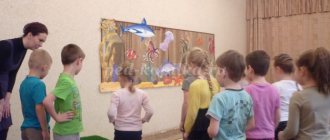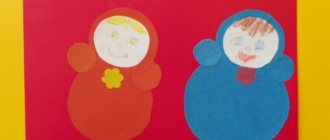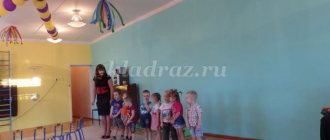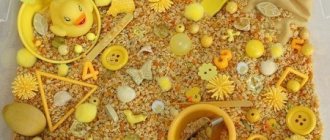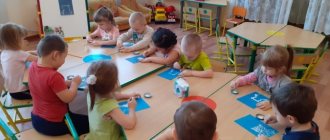MAGAZINE Preschooler.RF
Methodological development of GCD in accordance with the requirements of the Federal State Educational Standard on the topic “Treasure Island” for children with disabilitiesCompleted by: Olga Vasilievna Polishchuk, Teacher of MBDOU No. 75 “Swan”
Explanatory note
In accordance with the Constitution of the Russian Federation, a person, his rights and freedoms are the highest value. At the same time, every citizen of the Russian Federation has all rights and freedoms on its territory.
Children with disabilities are children whose health condition prevents them from mastering educational programs outside of special conditions of education and upbringing. These are disabled children or other children aged 0 to 18 years who are not recognized as disabled children in the established order, but have temporary or permanent deviations in physical and (or) mental development and require the creation of special conditions for education and upbringing.
Education is moving away from derogatory language that refers to people's functional deficiencies. New terms are being introduced: children with disabilities, children with health problems, children with special needs, children with special educational needs. The definition of the upbringing process is very multifaceted; the process itself is very complex even when it comes to healthy children. Of course, it turns out to be especially difficult when raising children with developmental disabilities.
Today we need to address the main problems of organizing the education of children with disabilities:
- insufficiently developed regulatory framework ensuring joint education of children with disabilities and normally developing peers in educational institutions
- the lack of a system for early diagnosis and identification of children with disabilities to provide timely correctional assistance and build an individual educational route for the child
- lack of preparedness of teaching staff to work with children with disabilities in conditions of joint education of children with disabilities and normally developing peers in educational institutions.
Therefore, in educational institutions, teaching staff undergo training, retraining and advanced training to work with children with disabilities. Programs are being formed to create a barrier-free educational environment that ensures unimpeded access for children with disabilities to educational institutions, as well as to ensure the organization of the educational process of children with disabilities using special technical means;
A particularly important comfortable psychological environment is one that allows a child with disabilities to feel normal in any organizational and pedagogical conditions. To do this, we, educators, must instill a tolerant attitude towards children with disabilities.
The purpose of the lesson is to help children cope with experiences that hinder their adaptation and socialization in the educational environment, and to optimize their intellectual activity by stimulating mental processes.
Tasks:
- Formation of adequate forms of behavior.
- Relieving the state of emotional discomfort.
- Correction of the cognitive sphere (memory, attention, thinking, perception)
- Development of gross and fine motor skills.
- Development of forms of constructive interaction and communication.
Integration of educational areas: “Cognitive development” , “Socio-communicative development” , “Artistic and aesthetic development” , “Speech development” , “Physical development” .
Group: senior preschool age 5-6 years
Basic terms and concepts: treasure island, pirates, chest, fairy, captain, tasks, treasure, opposite words.
Equipment and materials: pictures for the islands, a bottle, a letter from pirates, a treasure map, notes with tasks, a treasure chest, beads, monkey toys, a fairy toy, nuts, small animal figures, geometric shapes, a sandbox, flags, a tape recorder, pictures and illustrations "Emotions" .
Progress of the lesson
Warm-up
Goal: creating a positive atmosphere, liberation of participants.
Exercise "Greetings". Children are divided into pairs and, at the instructor’s command, quickly greet each other with different parts of the body: right hand to right hand, nose to nose, heel to heel, hip to hip, back to back, ear to ear, etc. Children can change several partners.
1. Organizational moment
Educator - Guys, on the way to work I noticed that there was an unusual bottle lying near the root of the tree. As I got closer, I began to wonder what was in it. And now, look at that very bottle... Let's see together what's in it?
And in it we found a letter.
Children are a treasure map.
Educator - let's go on an exciting journey together using this map. I will be the captain, and you are all my sailors. We have to go to different islands, solve riddles, solve tasks! And in the end, if we succeed, we will definitely find the treasure.
You can take your seats on the ship and raise the anchor. We straightened our arms and depicted waves, the noise of the wave “sh-sh-sh” . Let's swim!
Children: shhh...
Go ahead for adventure!
Children - Hurray!
2. "Island of Wild Monkeys"
Educator - here is the first island “Island of Wild Monkeys” . Our task is to count all the monkeys that live here. Can we handle it?
Children - Yes! Certainly! We are daring pirates, simple mathematicians. We solve all the tasks, count the monkeys.
"Let's Free the Monkeys"
Goal: develop logical thinking; practice ordinal counting, increasing and decreasing numbers by one.
"Where's the monkey"
Goal: to teach to perceive distance, to show that the result of actions not only in near, but also in far space depends on it; pay attention to the direction of movement in space and independently choose this direction.
Educator - Well done guys, and for completing the task correctly we are entitled to a pirate key.
And you and I are sailing further on our ship.
Children: shhh...
3. Psycho-gymnastics
Educator: Guys, pirates can be evil. Show it on your face. There are sad ones. Act sad. And our pirates are kind and cheerful. Show it on your face.
Children complete tasks.
4. "Island of Talking Parrots"
Educator - I see the next island along the route - “Island of Talking Parrots” . Our task is to get the next key. Are you ready for the challenge?
Children are always ready! Teacher - then take the telescope. Children make a spyglass out of their fingers. Teacher - what do you see?
Children are parrots!
The teacher tells the children that parrots are very smart, and they want to find out if the children can name words that are opposite in meaning to those that he will now name:
Deep - shallow Damp - dry Sunny - cloudy Cheerful - sad
Greedy - generous Fat - thin Large - small High - low
Long – short Wide – narrow Curly – bald Dark – light
Wonderful - terrible
Educator: Well done guys! The parrots are happy with your answers and for this task we get a second coin.
It's time to move on. Forward to the ship!
Children: shhh...
5. Finger gymnastics
Educator: Well, now we’ve got our fingers ready for gymnastics. We are strong and brave pirates, we are not afraid of storms or thunderstorms. We will follow our captain even in snowstorms and frosts!
- "Sea Sprays" . Children shake off the “sea spray” - pat their bodies from feet to shoulders.
- "Visorless Cap" . They adjust the “ribbons of the cap” - they stroke the forehead with the hands moving towards the back of the head.
- "Kiss of the Sea Wind" . The warm wind caresses the face, touches the lips, on which the salt of the sea is felt - they stroke the face.
- "Horizon" . Children bend over and look to the sides, hands near their eyes - through “binoculars” they look at the horizon.
- "Apple" . Children stand in a circle, hold their shoulders, sway, and smile. Then they throw and catch colorful balls.
- "Ship on course" . Gymnastics are carried out, reminiscent of the nautical alphabet, signals with flags.
6. "Island of Tsar Saltan"
Educator: And now children, let’s go straight east, past Buyan Island,
To the kingdom of the glorious Saltan...” There we will solve the tasks, get the key and hurry. We will all find the miracle treasure, and we will go home.
To get the key from Tsar Saltan, we must complete 3 tasks.
The first task will be as follows - some villain mixed up all the magic nuts of the squirrel from the fairy tale “About Tsar Saltan” . Your task is to return everything to its place and distribute the nuts in the plate (by color, size, shape) and distribute them among the compartments. For this task, the teacher prepared and decorated different types of nuts.
The second task is to lay out strips of beads of different colors. With the help of the teacher, shape the rainbow, choosing the right color.
Goal: learn to manipulate small objects, develop tactile perception, fine motor skills, and grasping with a pinch.
Task number three - For a good mood, we will create a common sunshine. I have rays and a smiley face on a piece of paper where our sun will appear. We take the rays and glue them to the sun!
For this task we receive the third key and move on. Forward to the ship!
Children: shhh...
7. Psycho-gymnastics
Oh, what great guys!!! Aren't you tired?! Now we will all return to the circle, take two deep breaths and exhale, close your eyes. Imagine that you are in the most extraordinary place on earth. Let's say hello to the sun!
Hello, golden sun! Hello, blue sky! Hello, free breeze! Hello, little oak tree!
We live in our native land, I love you all!
8. "Treasure Island"
Educator - we have sailed to treasure island! New adventures and a treasure hunt await us!
Exercise “Unearth a treasure” (we do the exercises using a table for drawing with sand). Variation of the game “Wonderful bag”
This version of the exercise is offered to the child in the form of a fairy tale: “In a fairy-tale country there lived a beautiful fairy. She lived in a magical forest with fabulous inhabitants. But she also really liked the sandy country next door. She loved to fly over this sandy country and admire the dunes and sandy seas. One day, when she was flying over a sandy country, a sandstorm arose, so strong that the Fairy lost all her magic figures. The fairy was very upset, because without these figures her country would perish. Let's help find them and bring the fairies back. And for this, she will give us the last key to the magic treasure chest.
Children complete tasks, look for figures in the sand (animal toys and geometric shapes).
Educator: Personally! You found the figures, and for this the good fairy gave us the last key. Now we can open the magic chest and get treasures.
Children insert keys into locks and open the chest. At the bottom they find “gold medals” , pencils and books.
9. Summing up
Educator: Our journey has come to an end. Did you guys like it?
What do you remember most?
Which task was the most difficult?
You all were great today, thank you all very much.
Expected Results
- development of children's cognitive activity;
- development of general intellectual skills: techniques of analysis, comparison, generalization, grouping and classification skills;
- developing the ability to navigate a task, developing self-control and self-esteem;
- social prevention, development of communication skills, correct behavior.
Conclusion.
After writing and implementing the methodological development of educational activities for children with disabilities, I came to the conclusion that these children are no different from healthy children. “uniques” in their own way , to whom we need to find the right approach.
Before writing the lesson notes, I read special literature on how to properly organize and interest children with disabilities. The lectures that I read on the website where I am undergoing advanced training helped me a lot in my work.
Enormous work was carried out with the help of specialized specialists. I consulted with a staff psychologist, speech therapist, and physical education instructor. By collecting important information bit by bit, how to make classes interesting and, in turn, uncomplicated and exciting.
An important step in writing the final work was working with parents. It is very important for them that their children are treated with love and understanding.
Based on the above, I came to the conclusion that in order to achieve positive results in working with children with developmental disabilities, various methods, techniques and techniques are combined - traditional and non-traditional.
Experience has shown that psycho-corrective games are effective in corrective activities with children with a complex structure of the defect.
In order to organize work with children in society, it is necessary to teach them to play, perform the necessary actions, speak correctly, etc. and the result of all correctional and developmental activities is the transfer of knowledge acquired during the learning process into play activities. Therefore, correctional and developmental work with children is planned in close cooperation with teachers, parents, medical personnel, kindergarten staff and other institutions.
When preparing my notes, I made psycho-gymnastics important to me. It is adjacent to psychological and psychotherapeutic methods, the common goal of which is to preserve mental health and prevent emotional disorders in children. With the help of psycho-gymnastic exercises, children learn the ABCs of expressing emotions - expressive movements. With the help of psycho-gymnastic exercises, children master communication and empathic abilities, observation, visual, motor-auditory, kinetic and spatial memory, fine and gross motor skills of the body, and the ability to cope with negative emotions. They become more restrained and resistant to stressful situations. There is an activation of children's imagination, creative self-realization in movement. In addition, children develop the following skills: to navigate the diagram of their own body, change the state of muscles (tighten and relax them), copy complex movements (specific movements of animals, etc.), control facial expressions and pantomime, describe their condition, adequately use language gestures and facial expressions.
I implemented all of the above in my lesson. Children are enthusiastic
they made faces, showed their emotions, tried to imagine themselves as pirates.
There were also some difficulties. At first I noticed that the guys were shy and timid. For this case, I had prepared pictures with emotions. We started looking at these files, copying and showing them. There were children who did not want to show “emotions on themselves . They simply picked up pictures with emotions and tried to change them correctly when changing the task. Basically I can say that psycho-gymnastics is very useful. Since the child receives moral peace, relaxation, he feels more open and relaxed.
Working with families of students with disabilities. The goal of this stage is to optimize parent-child relationships and increase the level of psychological and pedagogical competence of parents.
In modern society, parents are not always able to devote enough time to their children. Therefore, I provided for the involvement of parents in events in the lives of children related to work in the association of additional education. Participation in events (excursions, competitions, weekend trips) of parents with their children contributes to the formation of common interests, awakens emotional and spiritual closeness, which ultimately leads to a positive result.
After class, we (unfortunately) did not do many Treasure Island- . But next time I plan to organize an exhibition of joint drawings on this topic. The “Pirate costume competition made from waste or natural material” can have a very positive effect on the morale of children with disabilities .
By enriching themselves with new knowledge, adults learn to build a child-friendly, effective parenting strategy that allows everyone to feel comfortable and choose one or another type of interaction with the child in a specific situation.
One of the forms of working with children with disabilities is individual lessons at home (taking them for walks in the yard, excursions to the park, square, etc.), which take place 2-3 times a week for 2 hours, or for 1 hour - 4 times a week. The structure and content of education vary depending on the physical, mental state and age characteristics of the children.
At the parent meeting we discussed the possibility of a group outing. This trip will unite the team and give teachers, children and parents the opportunity to get to know each other better.
During the lesson, I tried to support the children. Supporting a child means believing in him. A child needs support not only when he feels bad, but also when he feels good. It must be remembered that there are factors that may seem harmless at first glance, but they can lead children to disappointment. Such factors may be overestimation of demands on the child from participants in the process of education, upbringing and development, rivalry between brothers and sisters, and excessive ambitions of the child.
When I suggested playing the games “Free the Monkeys” and “Where is the Monkey ,” the goal of which was to develop logical thinking; practice ordinal counting, increasing and decreasing numbers by one and teach to perceive distance, show that the result of actions not only in near, but also in far space depends on it; pay attention to the direction of movement in space and independently choose this direction. Not all children immediately understood what to do. Girl Aida did everything wrong. But I presented everything in such a way as to help her solve the tasks correctly and not worry about small failures.
In order to provide psychological support to the child, the adult must use a demonstration of satisfaction with what the child has achieved; use phrases that reduce tension, such as “We are all human and we all make mistakes” ; emphasize faith in the child’s strengths and capabilities.
I do not recommend reprimanding a child about an incorrectly completed task. We need to think about the problem together and look for ways to solve it. At the end, be sure to praise the child and express words of gratitude for the work done.
For good results and rapid adaptation of a child with disabilities, it is necessary to develop an individual curriculum - a curriculum that ensures the development of an educational program based on the individualization of its content, taking into account the characteristics and educational needs of a particular student.
Expected results and ways to check them.
When analyzing the results of teaching children with disabilities, I tried to compare the dynamics of the child’s indicators with those that he demonstrated at the very beginning of classes.
The teacher achieves a positive result if children are happy to meet with him, experience positive emotions from classes and communication with the teacher, if interest in cognitive activity is evident, children cope with more voluminous and complex information on the topic of classes than before, and are able to work with interest for a longer period of time. time, can analyze their work and rejoice at their successes.
The control process in working with each child is very individual and depends on the specific mental and physical characteristics of the child. I used control in the form of a conversation, a student’s story, mainly in the form of practical work.
My lesson begins with a general warm-up. Goal: creating a positive atmosphere, liberation of participants. Exercise "Greetings". Children are divided into pairs and, at the instructor’s command, quickly greet each other with different parts of the body: right hand to right hand, nose to nose, heel to heel, hip to hip, back to back, ear to ear, etc. Children can change several partners. Its task is to relieve the inertia of physical and mental well-being, increase muscle tone, “warm up” the child’s attention and interest in the activity, and set him up for active work.
From the very beginning of the work, I monitored the child’s progress, to see if he had lost the instructions, to prevent distractions and mistakes, but at the same time to try not to interfere, giving him independence. When the child did not understand, she explained the rules to him in more detail, began working with him, constantly reducing her share of participation in the joint activity. It is necessary to take into account the physical and psychological state of the child; he cannot work productively while sick and tired.
Children get tired of monotonous work; a change in activity is needed; to prevent satiety, a switch in work is necessary; for this purpose, the teacher invites the child to play. This could be the game “Associations” , “Gymnastics” , “Image of objects and animals” , etc. In my lesson, on the recommendation of a psychologist, I also used finger games (gymnastics) on the theme “Treasure Island” .
Children with disabilities are often characterized by emotional imbalance. It can be expressed not only in sudden changes and inadequacy of reactions, but also in awkward restless movements, intermittent speech, etc. To help such children, you can conduct play exercises aimed at achieving muscle relaxation.
Sometimes the child was lazy, for this reason he refused to complete the task with the words “I don’t know, I don’t know how . This happened in our lesson when we ended up on the “Island of Talking Parrots” . At the same time, with the participation of adults, he is able to do what is suggested to him. I did not give ready-made answers, but encouraged them to act independently, to search for ways to act.
The task of the teacher is to make learning interesting, joyful and at the same time developing.
New material necessary for assimilation must be divided into small portions and presented for assimilation in visual and practical conditions, consolidation is carried out through a large number of training exercises, and what has been learned is repeated many times on a variety of material.
The guys and I read stories about sea travelers, watched educational cartoons on this topic, and had conversations on the topic ? ” All this helped to conduct the “Treasure Island” .
When communicating with children who have learning difficulties, the teacher pays special attention to the quality of his speech, since the quality of children’s perception of educational material depends on this. The teacher’s speech should be slow, measured, consist of short and clear sentences, and emotionally expressive. It is necessary to pay attention to the child’s speech, talk to him, encourage him to talk, explain the meaning of what was said. And, most importantly, the general background of the teacher’s behavior and address to the child (facial expressions, gestures, intonation) should be benevolent, causing the child to want to cooperate.
The skill of the teacher is to learn to play with all sorts of deviations from the planned lesson and incidents, without violating the technical sequence, to make these deviations elements of the lesson, including them in the development of the topic, but never to make them the reason for the child’s comments. There was a small force majeure in our lesson. The children accidentally scattered beads from which they were supposed to make a rainbow. But this did not in any way affect the result of the work or their mood. We quickly collected everything and continued our exciting journey.
To better assimilate the material by children with problems in intellectual development, the following techniques are used:
- showing a sample of an action;
- its implementation by the child by imitation and model;
- figurative description of the action;
- game form of action;
- maximum division of the task into separate instruction phrases;
- the teacher’s explanation at the beginning of the enactment and during the child’s action.
Due to the enormous role of the family and its immediate environment in the processes of a child’s development, it is necessary to organize education in such a way that could stimulate this development as much as possible and smooth out the negative impact of the disease on the mental state of the child.
To create favorable conditions for upbringing in a family, it is necessary to know the characteristics of the child’s development, his capabilities and development prospects, maintain the correct daily routine, organize purposeful activities, form adequate self-esteem and the correct attitude towards the defect, and develop the volitional qualities necessary in life.
Often parents, wanting to save their child from difficulties, constantly take care of him, protect him from everything that could upset him, and do not allow him to do anything on his own. Such upbringing can lead to the development of passivity and refusal to act. The kind, patient attitude of loved ones must be combined with a certain level of demands on the child. You need to gradually develop the right attitude towards your condition, towards your capabilities. Depending on the reaction and behavior of the parents, the child will view himself either as a person with disabilities, or vice versa, as a person fully capable of achieving certain successes. Parents should not be ashamed of their child's illness. Then he himself will not be ashamed of his illness, withdraw into himself, into his loneliness.
Work with parents is built through individual conversations, consultations, and joint activities.
As a result, I can confidently say that the general development of children with children with disabilities provides the opportunity for their successful socialization and social adaptation in modern society.
The problems of additional education for students with disabilities include the following aspects:
- — availability of additional education for children with disabilities;
- — professional and personal growth of additional education teachers in the new educational conditions;
- — opportunities for social partnership in the implementation of additional education programs;
- — adaptation of additional education programs taking into account the special educational needs of children with disabilities;
- — variability and effectiveness of means, methods of technology for the development of the motor, cognitive, emotional sphere, volitional qualities and self-confidence of children with disabilities, their social adaptation and creative development;
- — psychological and pedagogical support for families with children with disabilities.
Bibliography:
- Constitution of the Russian Federation (adopted by popular vote on December 12, 1993)
- Law of the Russian Federation dated December 29, 2012 “On education in the Russian Federation”
- Berezhnaya N. F. The use of a sandbox in the correction of the emotional-volitional and social spheres of children of early preschool age. Preschool pedagogy. January-February, 2007.
- Raising and teaching children with developmental disabilities.; No. 2 2005
- Raising and teaching children with developmental disabilities.; No. 4 2005
- Grabenko T. M., Zinkevich-Evstigneeva T. D. Correctional, developmental and adaptive games. – St. Petersburg: Detstvo-Press, 2002. -208 p.
- Efimenkova L.N. Formation of speech in preschool children. M.: "Enlightenment" , 1981.
| Next > |

